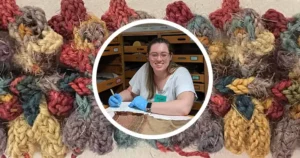Nearly 2,000 years ago, the Nazca people lived on the southern coast of Peru, close to the shore of the ocean on one side and bordered by a desert on the other. They were a farming people who relied on agriculture and sophisticated irrigation techniques to help their civilization thrive. They were also skilled potters and weavers, creating beautiful fabrics with intricate decorations.
It’s those fabrics that Katie Cianciola is interested in.
“I’m interested in textiles, specifically … and what those can tells us about the culture that made them, whether it’s through the symbolism in (the designs) or the craftsmanship and what makes that unique,” Cianciola explained.
Cianciola graduated in from UW-Milwaukee in December with a Master’s degree in anthropology and a certificate in Museum Studies. For her thesis work, she studied fragments of fabric left behind from the Nazca, scraps that are literally thousands of years old. She is working with the Milwaukee Public Museum to analyze their Peruvian textiles collection, an involved process that includes studying the cloth to learn more about its designs and how it was made; determining where the artifact came from and how it arrived at the Museum; and making inferences about the Nazca people based on the remnants they left behind.
On any given day, Cianciola may be counting the number of stitches in a swath of cloth or trying to fit scraps together like puzzle pieces so she can guess how the fragments may have been associated with one another. She’s also looking at the bigger picture: Where did the garments come from, and how were they used? Were they clothing for funerals or ceremonies? Or were they worn every day?
The answers to these questions are important, said Cianciola, and not just for knitting or textile nerds like herself. By studying these aspects of ancient cultures, researchers gain a better understanding of how civilizations like the Nazca operated, grew, and adapted over time.
One of the more fascinating features of the textiles that Cianciola is studying is the intricate decorations stitched at the edges of the garments. They’re made by a technique called “cross knit looping.”
“This technique was primarily associated with the Nazca culture in Peru,” Cianciola said. “It’s not knitting, but it’s something similar in that (they) probably used only a single needle to loop the thread into itself in rows and columns. Researchers think they used a single needle because (double) knitting needles haven’t been found in Peruvian contexts.”
The needles used to make these decorative loops appear to be actual cactus needles, she added. Cactus thorns have been discovered in Nazca sewing kits.
The Nazca used cross knit looping to make all sorts of decorations for their clothing. Cianciola has studied fabrics stitched with birds or flowers that seem as though they would dangle from the hems. Some are decorated with figures that look human. She’s heard of other collections featuring different decorative animals like bees.
By studying the stitching, Cianciola, historians, and artisans can understand how these garments were made.
“I know there have been different workshops in Perus where the people there are recreating this technique or sharing how they’re creating textiles,” Cianciola said. “Communities are still involved (in creating) textiles and learning about it that way. I think it’s really important.”
Many artifacts, including items from Nazca archaeological sites, have been looted over the years, she explained. If the artifacts can’t be immediately repatriated, at least Peruvian people are still able to learn about Nazca history through the actual craft.
Cianciola hopes that her experience in the Milwaukee Public Museum will help her land a job as a curator or registrar. She enjoys the field work of anthropology – scouting for artifacts on archaeological dig sites – but museum work lets her delve into the analysis and research that she loves.
“I really like getting to care for objects and make sure that they’re available and accessible to people interested in researching them,” she explained. “I’ve definitely enjoyed my time here in the Museum Studies program.”
By Sarah Vickery, College of Letters & Science
